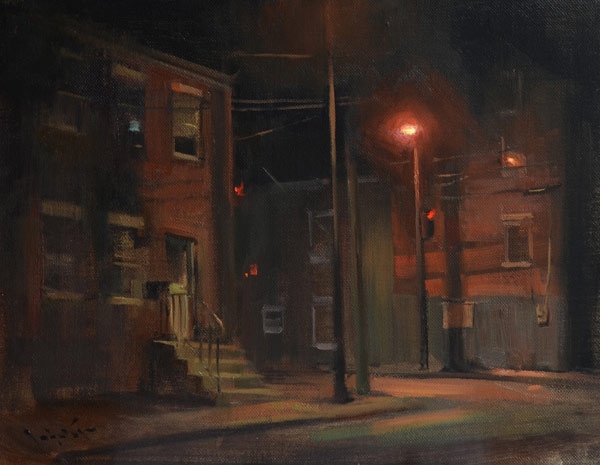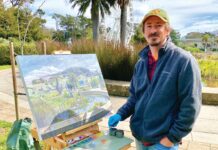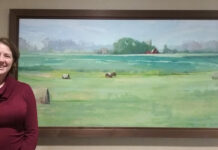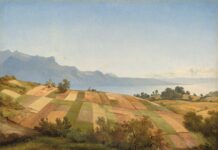
What’s the big deal about painting a nocturne? You just have to figure out how to get some light, right? John P. Lasater IV and his friend Jason Sacran are both building big reputations in the art world, and a chunk of that is for their nocturnes. Five minutes with either of them reveals a wealth of knowledge about painting at night — beyond buying a penlight.
Lasater and Sacran will be sharing the stage at the Plein Air Convention & Expo (PACE), slated for April 13-17 in Monterey, California. They’ll be painting nocturnes on the demonstration stage, but they won’t need LED reading lights clamped on their easels: There will be lights. “It’s the guys from Arkansas, coming to do a nocturne demonstration,” muses Lasater. “We’ve painted a lot together, so that will come through. Our philosophies are similar. We will talk about some of our experiences together, and we will complement one another and talk about each other’s pieces. It will probably almost seem like one person talking. We paint pretty similarly. Neither of us tends to exaggerate the colors we see.”

“Lights of Brady Street,” by John P. Lasater IV, oil, 14 x 18 in.
The two friends will also lead groups in painting nocturnes en plein air at least one night during the convention. Lasater recommends that interested participants remember to bring some clip-on reading lights to affix to easels. He says he uses about five at a time to illuminate his palette and surface. Lasater finds the LED lamps for about $5 each. “It’s my only change to my equipment when painting nocturnes,” he says.
The LED lights tend to cast a cool light, so Lasater has to guard against painting things too warm without realizing it. He prefers to paint with a streetlamp nearby to mitigate the effects of his clamp-on lights — but not too much light, or his eyes are too dazzled to take in the night scene. The going gets easier when Lasater has covered his surface with paint, obscuring its whiteness. But then he still has to contend with a few more challenges.

“Corridor,” by John P. Lasater IV, oil, 10 x 12 in.
“I can move the clips to place them at different angles to change the light, and this helps with glare, which is always a challenge,” Lasater says. “The darker shades tend to pick up a lot of reflection. So do the horizontal brushstrokes. If someone is to my right or left, they are seeing different reflections than I am.”

“Cellar Door,” by John P. Lasater IV, oil, 20 x 24 in. Collection Big Cedar Lodge, Ridgedale, Missouri
He does have some advice on painting nocturnes: “Make the colors more mature and true to life,” says Lasater. “Be aware and understand the palette. Keep color saturation hierarchy correct. Your values may look fine on the canvas, but the saturation hierarchy has to be respected as well.”

“Basilico Patio,” by John P. Lasater IV, oil, 9 x 12 in.
The artist points out that painting a nocturne under lights indoors isn’t such a crazy idea — in fact, good training for painting a nocturne may very well be painting a still life. “When squinting at a night scene, you see that there are no hard edges except around sources of light,” says Lasater. “You paint the planes of buildings — the surface texture — and let the edges just disappear. It’s about softening and blending. That’s why still life painting is a great way to train for nocturnes. Softer edges, highlights where light is reflecting off of metal or glass … nocturnes can be painted very quickly if you adopt some of the techniques.”

Lasater painting one of the chapels on the grounds of Big Cedar Lodge, in the Ozark Mountains
Lasater has had a great year, one that was recently capped by a gig painting large plein air scenes for a Missouri resort. Lasater, Sacran, and R. Gregory Summers were asked to spend two weeks over the late summer and early fall painting scenes on the grounds of Big Cedar Lodge.

Jason Sacran working on location at Big Cedar Lodge
“I call them commissions, but it really just felt like us going around and choosing the subject we wanted to do and making sure that it fit what they wanted,” says Lasater. “It was a great experience, going around and choosing subjects and angles. They wanted large canvases, and it was great to be able to do multiple sessions outdoors. I already had been experimenting with bigger canvases outdoors, but now I am finally at a place in my career where I can do that anywhere.”

One of R. Gregory Summers’ pieces hanging in Big Cedar Lodge
During one of Lasater’s painting sessions, the spa owner told the artist to make sure he was painting when a special guest arrived. The VIP was a developing artist by the name of George W. Bush. Lasater and President Bush talked shop. “President Bush commanded the conversation in a kind way, and was excited to talk about art,” reports Lasater. “He is really touched by the experience of painting, and it was great to connect with him on that.”

Lasater talks art with President George W. Bush and Jeanie Morris, one of the founders of the spa.
Lasater and Sacran will be teaching at the Plein Air Convention & Expo, which will be held April 13-17 in Monterey, California. Last year, more than 700 artists basked in the perfect weather and learned from 70 instructors. This year, organizers expect even more participants. Learn more here.




